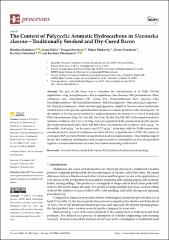The Content of Polycyclic Aromatic Hydrocarbons in Slavonska slanina—Traditionally Smoked and Dry-Cured Bacon

View/
Date
2022Author
Kartalović, Brankica
Puljić, Leona
Kovačević, Dragan
Markovčić, Mateo
Vranešević, Jelena
Habschied, Kristina
Mastanjević, Krešimir
Metadata
Show full item recordAbstract
The goal of this study was to determine the concentrations of 16 PAHs (PAH16)
naphthalene—Nap, acenaphthylene—Anl, acenaphthene—Ane, fluorene—Flu, phenanthrene—Phen,
anthracene—Ant, fluoranthene—Flt, pyrene—Pyr, benz[a]anthracene—BaA, chrysene—Chry,
benzo[b]fluoranthene—BbF, benzo[k]fluoranthene—BkF, benzo[a]pyrene—BaP, indeno[1,2,3-cd]pyrene—
InP, dibenz[a,h]anthracene—DahA and benzo[g,h,i]perylene—BghiP) in Slavonska slanina traditionally
smoked bacon over open fire and industrially smoked on a smoke generator with a heated plate. In
the samples of Slavoska slanina smoked in a traditional manner, the presence of 11 out of 16 analyzed
PAHs was determined (Nap, Anl, Ane, Fln, Ant, Phen, Flt, BaA, Pyr, BbF, BkF). In the samples smoked in
industrial conditions, only 2 out of 16 (Nap, Anl) were quantified. In the samples smoked with open fire
(the traditional method), PAH4 (BaA, BaP BbF, Chry) concentations were as follows: 14.84 µg kg−1
in
the middle, 10.60 µg kg−1 on the surface and 17.37 µg kg−1
in the skin, while the PAH4 content in the
samples smoked in industrial conditions were below the level of quantification (<LOQ). The content of
carcinogenic BaP was below the limit of quantification in all investigated samples. These findings support
the fact that traditional smoking may result in a product safe for consumption, as far as the prescribed
legislative recommendations are concerned, but constant monitoring is still needed.
